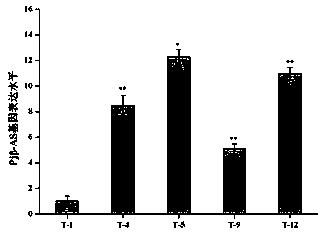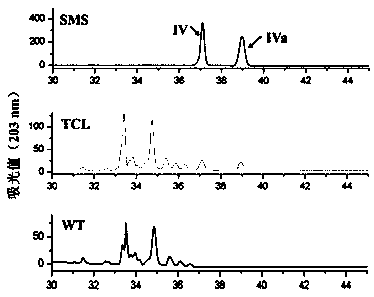Application of panax japonicus beta-amyrin synthase gene Pjbeta-AS
A technology of balsamol and synthesizing enzymes, applied in genetic engineering, plant genetic improvement, enzymes, etc., can solve the problems of high prices of medicinal materials, high time costs, low land utilization, etc., and overcome the long period of artificial cultivation Effect
- Summary
- Abstract
- Description
- Claims
- Application Information
AI Technical Summary
Problems solved by technology
Method used
Image
Examples
Embodiment 1
[0017] Example 1: Cloning of the full-length ORF of the Panax ginseng β-amyresinol synthase gene
[0018] (1) Extraction of total RNA from Panax ginseng
[0019] Select Ginseng cells that have grown for 35 days, and use the guanidine isothiocyanate method to extract their total RNA. The mortar, pipette tip, and centrifuge tube used are all washed, and soaked in 0.1% volume fraction after overnight shaking. Soak in diethyl pyrocarbonate (DEPC) aqueous solution for more than 24 hours, take it out at 121°C, 1.034×10 5 Pa steam sterilize for 40 minutes, and dry at 50°C for later use. Add an appropriate amount of alcohol to the cleaned mortar and burn the mortar and medicine spoon. After the mortar cools down, take 1.0 g of beaded ginseng cells, grind them into powder in liquid nitrogen, and add 5.0 mL of guanidine isothiocyanate extraction buffer and 50.0 µL of β-mercaptoethanol. Transfer the grinding solution to a 2.0 mL EP tube, add 1 / 10 volume of 2 M sodium acetate (pH 4.0)...
Embodiment 2
[0027] Example 2: Construction of a plant expression vector containing the ginseng β-arsinol synthase gene
[0028] Using pCAMBIA1300S as the plant expression vector, use Sac I and Xba Ⅰ Double enzyme digestion of the pGEM T-easy vector and pCAMBIA1300S plant expression vector containing the β-amyresinol synthase gene of G. , extract the plasmid for polymerase chain reaction and enzyme digestion verification, and obtain the plant expression vector containing the gene.
[0029] The above-mentioned linking of the ginseng β-amyresinol synthase gene to the regulatory sequence of the plant expression vector forms a plant expression vector containing the gene, and the expression vector can be used to produce oleanane-type saponins ( bamboo ginsenoside IV and bamboo ginseng saponin IVa).
Embodiment 3
[0030] Example 3: Obtaining of Agrobacterium tumefaciens strains containing the plant expression vector of Ginseng ginseng β-arsinol synthase gene
[0031] The plant expression vector containing the β-arsinol synthase gene of Panax ginseng was transformed into Agrobacterium tumefaciens EHA105, and polymerase chain reaction was performed to verify that the plant containing the β-arsinol synthase gene of Panax chinensis The expression vector has been successfully constructed into the strain of Agrobacterium tumefaciens. The specific construction method is as follows:
[0032] Prepare competent Agrobacterium EHA105 by calcium chloride method, add 5mL LB liquid medium (containing rifamycin 25mg / L) into a 50mL sterile centrifuge tube, and pick well-grown cells from the plate with a sterilized toothpick A single colony of EHA105 was inoculated in the centrifuge tube, cultured in a constant temperature shaker at 28°C at 180 rpm for 16-18 hours, and the next day, 2 mL of the culture ...
PUM
 Login to View More
Login to View More Abstract
Description
Claims
Application Information
 Login to View More
Login to View More - R&D
- Intellectual Property
- Life Sciences
- Materials
- Tech Scout
- Unparalleled Data Quality
- Higher Quality Content
- 60% Fewer Hallucinations
Browse by: Latest US Patents, China's latest patents, Technical Efficacy Thesaurus, Application Domain, Technology Topic, Popular Technical Reports.
© 2025 PatSnap. All rights reserved.Legal|Privacy policy|Modern Slavery Act Transparency Statement|Sitemap|About US| Contact US: help@patsnap.com



